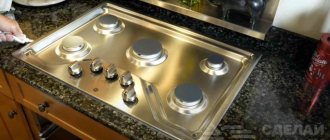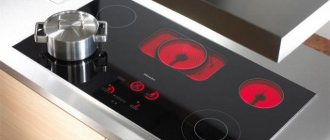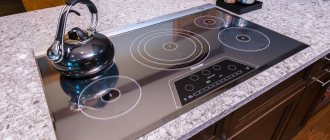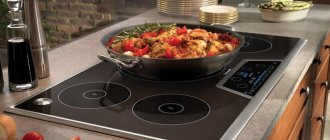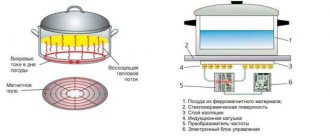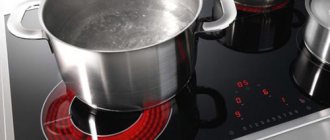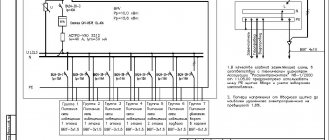Built-in stoves are the norm for a comfortable and functional kitchen. Such panels do not take up much space and fit perfectly into any interior. And what new opportunities they have! They cook themselves, monitor the boiling of the dishes themselves, and even regulate the heating of the burners “according to the recipe.” Current stoves have many advantages, but we should not forget about the disadvantages.
The best manufacturers of hobs - which company to choose
There are many manufacturers of kitchen appliances, and there are even more worthy models in their lines. This can sometimes make it seem very difficult to make the right choice. In fact, hobs within their price categories have minimal differences - the main thing is that the brand is proven.
Excellent surfaces are produced by companies that everyone knows:
- Pyramida;
- Hansa;
- Bosch;
- Hotpoint-Ariston;
- Gorenje.
We have already reviewed the best representatives from the range of these companies in our recent rating of induction hobs. But before you go shopping for the model you like, let’s decide on the principles of operation and the main criteria for choosing a hob.
Recommendations: 12 best gas stoves
16 Best Induction Cookers
17 best electric stoves
A few additional tips
Having received information on how to choose an electric hob, we recommend reading a small selection of useful tips:
- When we choose a built-in, we be sure to check its dimensions, as they are standard, but there are exceptions. Be especially careful when planning a corner installation.
- The connection must be made to a separate line designed for the appropriate load.
- It is important to choose the right circuit breaker; you can read how to do this on our website.
- Without experience, it will be problematic to install and connect the electrical surface yourself, so we recommend using the help of a specialist.
Operating principle and design of the hob
After being inserted into the kitchen countertop, the hob seems to become its continuation, which is why it appears very compact in appearance. But under the working surface there is also a metal case in which the main elements of kitchen appliances are hidden: gas pipes or electric heaters, as well as protective and control electronics.
On top there are only handles, buttons or sensors with which we turn on, turn off and adjust the heating intensity of the burners. The most advanced models already have processors installed - they themselves control the operation of the stove according to given programs.
Different stoves have their own operating principles:
1. In gas systems, turning the knob on the control panel opens the valve of the corresponding burner, releasing a stream of blue fuel through it. In order for the stove to light up, you need to bring a match to the divider or use the built-in ignition, which will knock out a spark and ignite the gas.
2. Most electric stoves have high-resistance heating elements instead of burners. When voltage is applied to them, they become hot, transferring heat directly to the cookware or to the surface of the hob.
3. Induction cookers use a different system. Here, electromagnetic coils are installed under the glass, which themselves do not heat up. But the EM field they create heats the bottom of the dish (however, for this to happen it must contain a large amount of iron, which is susceptible to magnetic influence).
Functions
Technology is constantly getting smarter, including stoves. Modern units can do a lot of things that greatly facilitate and speed up the process of cooking:
- automatic boiling - the heating process occurs at maximum power, but as soon as the goal is achieved, the intensity decreases;
- timer - you can set the cooking time, after which the work will stop, or the device will sound a sound signal;
- temperature maintenance mode – allows the finished dish to remain hot for a long time;
- auto programs - a book of recipes saved in the device’s memory and allowing you to cook with minimal human intervention: you only need to add ingredients and stir from time to time, and the device regulates the heat intensity and time independently;
- residual heat indication - will show which burner has not yet cooled down, so as not to get burned, and it can also be used for heating without wasting electricity;
- pause – you can stop cooking with one touch, and then just as easily restore it without having to set the mode again.
Evaluate which of these options will really be useful to you, since for each of them a certain amount is added to the cost of the device.
To ensure safe operation, developers integrate various sensors and options into the equipment to protect the user from possible negative consequences.
- Emergency shutdown - if the temperature exceeds the permitted standards, a shutdown occurs.
- Self-diagnosis – the technician will let you know if there is a problem with an audible signal or a special message on the display.
- Dish presence sensor - the device does not start working if there is no pot or frying pan.
- Child protection - locking so that a child cannot switch anything.
Types of hobs
Gas
Such hobs are traditionally more expensive than electric ones, but this purchase is definitely profitable. This is all thanks to the difference in tariffs for blue fuel and energy - gas is much cheaper. And even if your house is not connected to the central highway, it is quite possible to use a balloon one.
READ ALSO
18 Best Cookers
Pros:
- Cheaper to operate;
- High heat output of the burners – food cooks faster;
- You can use almost any utensil;
- Smooth flame adjustments;
- No need to wait for the stove to heat up.
Minuses:
- Fire hazard;
- Air pollution in the kitchen by combustion products;
- Soot forms on dishes faster.
Unfortunately, city residents whose apartments are located above the 10th floor cannot use gas panels - building and fire codes directly prohibit this.
Hob selection options
Shape and dimensions
The rectangular shape of the hob is the most common, and it is also easier to install such equipment into the countertop. Most of these stoves (with the exception of a few exclusive models) have a length of 60 cm. But the width can vary between 25-90 cm - depending on the number and order of the burners.
There are other panel formats:
1. Round;
2. "Honeycomb";
3. Triangular.
All of the listed options, except for the hexagonal “honeycomb”, are usually chosen by owners of spacious kitchens, where there is no need to save square centimeters of the working area.
To determine the optimal panel size for your kitchen, plan the room in advance and take the necessary measurements.
Next you will need to make a calculation based on the following recommendations:
1. A free gap of at least 30 cm should be left from the side wall to the stove. This is where you will place pots and pans with ready-made dishes.
2. From 60 cm to 1 meter is allotted to the cutting table - this is enough to prepare products. You can’t do less, because it can cause burns; more is simply undesirable, otherwise you’ll have to make a lot of unnecessary movements while cooking.
3. The sink should be located 40-60 cm from the side wall to prevent splashes from flying onto it. And don’t forget to write down the width of the kitchen sink itself - it’s also needed for calculations.
Now all that remains is to add up all the recommended gaps and the width of individual zones, and subtract the amount from the total length of the wall where the table, sink and stove will be located. The resulting figure is the maximum allowable width of your hob.
Let's see what the manufacturers offer us:
1. One- and two-burner Domino stoves come in a standard width of about 30 cm.
2. Three-burner stoves can occupy from 45 to 73 cm of the working area.
3. A four-burner classic is usually 60 cm wide, but electric models can reach up to 90-100 cm.
4. Five or six burners are already a choice for a spacious kitchen: there is no such equipment smaller than 75 cm.
Number of burners
Here you should take into account the composition of the family and the volume of daily cooking - this will determine the number of burners required for operation:
1. One is an option for a tiny kitchen or summer cottage. Such panels are usually taken in addition to two-burner ones.
2. Two - installed on compact Domino stoves, again intended for small kitchens. Such a mini-stove is enough for a family of 1-2 people, and if the number of household members increases, you can always buy another domino and build it next to it.
3. Three - a somewhat unusual, but very convenient format that is quite suitable for preparing a full meal. Due to one “retired” burner, the stove can have a width of 15 cm less than a full-size classic. It really saves space in the kitchen, but at the same time copes with all the main tasks.
4. Four is a standard stove on which you can cook anything. But as practice shows, even in a house where 4 people live, only 3 burners are occupied on the stove at a time. The fourth is used to “settle” ready-made dishes or on holidays.
5. Five – it is taken not so much by the number as by the format of the additional burner. As a rule, it is very large and powerful or even has an oval shape, which allows you to cook dishes in wide and non-standard dishes.
Surface type
The material from which the visible part of the panel is made determines not only its appearance, but also the features of caring for the equipment you like. The choice is quite wide, but you will have to carefully weigh the pros and cons, and honestly answer the question of how carefully your family treats kitchen appliances.
1. Stainless steel
It looks impressive, fits perfectly into most interiors, and is quite durable. It is mainly used for the production of gas panels, but European brands are already trying to use this material in induction cookers.
Alas, it is almost impossible to constantly maintain the ideal cleanliness and bright shine of a metal surface - fingerprints, stains and frozen drops of water will appear on it every now and then. If you decide to buy such a slab, look for a product with a matte finish - here the stains are less noticeable.
2. Enameling
Good old enamel is used to produce inexpensive gas and electric stoves with pancakes, but it pleases the eye with an abundance of colors. It is easy to care for if you wash it regularly, but it is afraid of pinpoint impacts - under strong mechanical stress it breaks off into pieces.
3. Glass ceramics
Today it is the most popular material for the production of electrical and gas panels. For the latter, they even came up with the “gas under glass” technology - it looks fantastic. But still, glass ceramics are typical for electrical appliances.
The beauty is that not the entire surface is heated here, but only the area above the burner. That is, you can safely wipe off any grease splashes from the stove without getting burned. But this feature of glass ceramics also hides its main problem - due to the temperature difference, stress is created inside the material.
Once a cold drop hits the surface, the panel can easily crack. An unfortunate fall of a knife or a pan landing with a crash also often leads to cracks.
Glass ceramics are difficult to care for: they cannot be cleaned with abrasives, and spilled liquids must be cleaned up immediately, especially if they contain sugar. When heated, it destroys the structure of the material, reducing its strength. Why, with so many shortcomings, does it remain the most popular? Yes, because it heats up in a record 3-4 seconds and at the same time can withstand temperatures up to +600 °C.
4. Tempered glass
It looks no worse than a glass-ceramic surface, and is a little less fussy to care for. However, it also requires frequent and thorough cleaning using mild products.
Control
Any hob has its own control system. It can be represented by rotary handles or a “smart” touch panel - the choice depends on the functionality of the stove.
1. We have long been accustomed to the classic knobs that all gas stoves are equipped with, although their capabilities are limited to standard on/off and heating control. It is important to pay attention to their location.
The handles should be kept as far away from the burners as possible, otherwise they will get hot and either melt or you will get burned. Also make sure that the rotary knobs are located closer to the small burner, on which you will not place wide dishes.
2. You will have to get used to the electronic display and keep the instructions at hand at first, but the result is worth it. The touch panel allows you to implement many more functions and control options in the electric furnace, such as:
- Support set temperature;
- Operating time programming;
- Reducing power when boiling food;
- Automatic switching on/off of burners;
- Saving frequently used modes in the device memory.
Once you get comfortable with all these functions, cooking can become less of a hassle. But such “smart” panels cause irritation for experienced housewives - temperature control will be enough for them.
Burner type
Hob burners are divided not only into gas and electric - within these large families there is their own classification of burners. Which ones should be in your model, and which ones you can do without, is up to you to decide. We will simply tell you about their capabilities.
Types of gas burners:
1. Standard round - the most common type of burner, the thermal power of which directly depends on the diameter.
2. Double crown – due to the additional circular divider, it ensures faster heating of the wide bottom of the cookware.
3. Triple crown - even more effective than double crown.
4. Oval burner - used for cooking in non-standard dishes (duck pot, goose pan or fish pan). It also copes well with heating large pans.
5. Coup de feu – burner “without flame”. Of course, it is here, but it is not shown outside. The fire heats up a cast-iron disk from below, on which the cookware is placed - ideal for simmering and slowly stewing dishes.
Electric burners are usually divided not by shape or size, but by heating method:
1. Cast iron pancakes - considered obsolete, not particularly aesthetically pleasing and spending too much time (and energy) on heating. To save at least a little, you will have to get used to turning off the oven a little earlier, leaving the dish to finish cooling on the burner.
2. Hi-Light – These strip heaters were not in fashion for long, but are still found in budget range models. “Gluttonous” and require 10-20 seconds to warm up.
3. Halogen - they are easily recognized by the bright glow of the working circle. These burners heat up very quickly, transferring heat to the hob, and the slowly dying lights serve as an excellent indication of residual heat.
4. Induction - they can hardly be called burners in the full sense of the word. Instead of a heating element, an electromagnetic coil is installed under the glass of the panel, which heats the bottom of the cookware directly. True, for this it must be perfectly smooth and have a thick layer of ferromagnetic alloy.
Classification by type of control
In addition to the energy source used, hobs are divided into separate types according to control methods and their types. The order of organization of the workplace where food preparation is carried out is also taken into account.
According to these indicators, there are the following groups of hobs:
- dependent;
- autonomous;
- sensory;
- push-button;
- mechanical.
Dependent surfaces are installed exclusively above the oven. Their management is interconnected. In most cases, their switches are mounted on the oven.
Autonomous, as their name suggests, are installed and operate completely separately from the oven.
The concept of touch panels is applicable only to induction and electric panel options. Working with such a panel is simple and can be done with a light touch of your finger. This device is much more practical and easier to maintain. It can simply be wiped with a damp sponge without touching the levers and control buttons.
Push-button panels provide for the presence of buttons directly on the structure or on the oven.
Mechanical panels are controlled by lever handles that rotate in both directions - a long-proven and reliable control method.
Which hob to choose
1. For single people and small families living in a house with a tiny kitchen, a two-burner Domino panel is suitable. Gas or electric - depends on the possibility of connecting to communications.
2. For a family of 3-5 people living in a house without a central gas pipeline, an electric stove with 3-4 burners is suitable. If you are looking for a budget option, purchase a glass-ceramic panel with halogen burners. If you want to reduce cooking time and at least slightly reduce electricity costs, it is better to fork out for an induction model under tempered glass.
3. For private houses in the suburbs, where interruptions in electricity and gas supply are possible, the solution would be to purchase a combined panel. A cheaper option is an enameled surface with 1-2 cast iron pancakes. If you want something more aesthetically pleasing, take the same enamel or stainless steel with glass-ceramic inserts - halogen burners will be hidden under it.
4. Do you have a spacious kitchen and love to cook? Feel free to take a large panel with 5-6 burners - a gas one, if you have a mains connection. In other cases, you will have to limit yourself to electric. The main thing is that it has extended heating zones for large dishes.
How much does a hob cost?
1. Compact two-burner electric dominoes will cost the buyer from 4500-5000 rubles (for a model with “pancakes”) and up to 120-150 thousand for induction. Gas ones are a little cheaper - from 4 to 90 thousand rubles.
2. Models with three burners are sold at a price of 8-40 thousand rubles, electric and combined ones go up to 180.
3. Classic 4-burner gas stoves have a fairly wide range of prices - from 5 to 250 thousand rubles. But for electric analogues it is even higher - from 6 to 350 thousand. Combined models ended up somewhere in the middle - they can be purchased ranging from 7 to 290 thousand rubles.
4. Manufacturers offer large gas stoves with 5 burners in the price range of 12-300 thousand rubles. Electric and combined ones are cheaper on average - 30-220 thousand.

